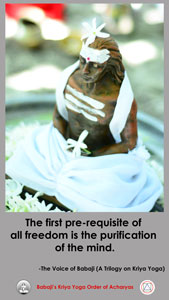How should we concentrate in practicing mantras?
by M. Govindan Satchidananda
Mantras are a language between levels of consciousness, so it is important to repeat them in such a way that one's consciousness both deepens and widens, like a seed which grows into a tree. In ordinary physical consciousness, our consciousness, even our identity is absorbed int the phenomena being experienced through the five senses. We are preoccupied with what we are seeing, reading, hearing, feeling on the skin etc. In ordinary dream consciousness, which includes daydreaming, our consciousness is also contracted and absorbed in memories, imaginations like anxiety, desire, judgments. To gain the benefit of mantra sadhana, therefore, one needs to concentrate on not only the sound or pronunciation of the mantra, but also on its meaning or what it is pointing to. The meaning may best be understood as a bhava or feeling, associated with such as ideas as love, surrender, strength, wisdom, abundance, radiance, peace. The benefit will be even greater if one can remember the state of consciousness one felt when one was first initiated into the mantra. The mantra is essentially a vehicle of consciousness, and it reminds us of that state which we were in during the initiation. Mantra initiation is such a sacred event, and requires much preparation on the part of both the initiator and the one receiving initiation. It is rare that for example, we observe a day of silence, and intensive practice of Yoga, and chanting around a mantra yagna fire, as we did prior to the mantra initiation. So, remember that state of consciousness, with its love, purity, equanimity, the wide calm and energy which you cultivated before and during mantra initiation.
The seed syllalbes germinated during the mantra initiation. Later, as one practices them on one's own, they will grow in an expansive way like a plant, if when practicing them, one sets aside other preoccupations. One may do this during routine activites which do not require much concentration, like walking or riding in a car, and even driving the car if one is on a familiar route without much traffic. Such practice also helps us to weed out mental anxiety and trivial thinking, which ordinarily drains us of our mental energy.
If practiced with an aspiration for that to which the mantra corresponds, whether it be love, wisdom, strength, abundance, enlightenment, for example, one creates the ideal conditions in which such states come down from the mental plane and manifest, even magically in the material plane. As our life is largely the consequence of our past thoughts, words and actions, that is our karma, as we replace old habitual thoughts with the mantra, the old karma tendencies lose their force and dry up. Such an aspiration however, must not contain any impatience, hope or doubt. It must be filled with feelings of confidence in the efficacy of the power of the mantra, and surrender to the Will of the Divine. The highest aspiration, is simply "Not my will, but Thy will be done." Then whatever one receives, will be in alignment with the Will of the Divine, and one will overcome the ego-based illusion of being "the doer."
When our minds are troubled by life's challenges, practice of the mantras can be performed as a kind of balm, to soothe the anxiety, sadness or agitation in the mind. Even if the mind is competing with the mantra recitation, the latter will gradually wear down the mental chatter, leaving one in a peaceful state.
Mantras can be done prior to the practice of meditation as an aid to calming and concentrating the mind, and preparing it for meditation.
It is best to practice the mantra continuously during a given period, or for a predetermined number, in order to develop one's will power; however, if circumstances demand that you put your attention elsewhere, the mantra sadhana should be temporarily put aside, until one can return to it with full or near full attention.
Copyright: M. Govindan Satchidananda, January 2005




